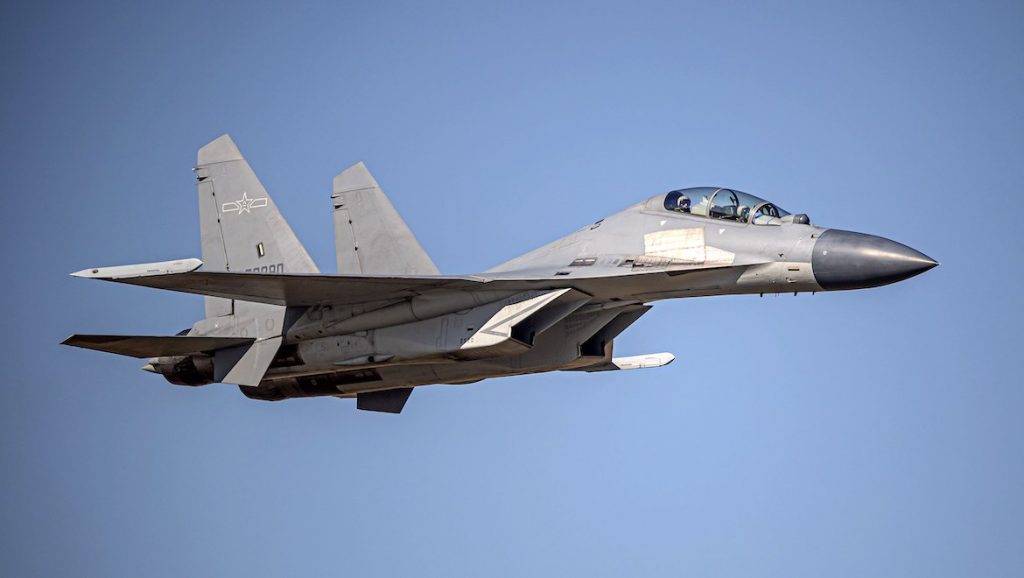
Following news revealed over the weekend that a RAAF Poseidon patrol aircraft was briefly intercepted by a Chinese fighter plane last month, Australian Aviation takes a deep dive into the J-16 fighter jet.
The Shenyang J-16 is a multi-role strike fighter jet built by Shenyang Aircraft Corporation and has been operated by China’s People’s Liberation Army Air Force (PLAAF) since 2015.
The jet is powered by two Shenyang WS-10A turbofan engines and is essentially China’s answer to the Russian Sukhoi SU-30 Flanker program, or the USAF’s Boeing F-15E Strike Eagle.
Internally, the J-16 has two seats and a sophisticated active electronically scanned array (AESA) phased-array radar, which allows it to monitor and target 8-10 subjects at the same time.
The fighter can carry up to 12 air-to-air missiles, along with a 30-millimetre cannon and satellite-guided bombs. It’s also capable of air-to-air refuelling through a drogue-and-probe system.
Over 170 J-16 airframes have been built as of 2021.
The jet is thought to have been first developed in the late 2000s, with the first flight occurring around 2011. The PLAAF took delivery of its first J-16s in 2014 before the fleet entered service in 2015.
According to Chinese news sources, the PLAAF began using the J-16 in combat training in late 2021,
A future variant of the J-16 is being developed in China that would see the jet manned by a single pilot, with the aid of artificial intelligence.
On Sunday, 5 June, the Australian Defence Force confirmed that a J-16 had “cut across the nose” of a RAAF P-8 Poseidon, in what Defence has called a “dangerous manoeuvre” that was a safety threat to the Australian crew.
The incident had taken place days earlier on 26 May over the South China Sea, while the RAAF Poseidon was undertaking “routine maritime surveillance activity” in international airspace.
It saw the fighter jet accelerate so close to the Australian aircraft that a “bundle of chaff” was ingested into its engine.
Defence Minister Richard Marles said the P-8A returned back to base safely and added the incident would not deter the RAAF from continuing to fly over the disputed area.
Prime Minister Anthony Albanese said, “In the Australian government’s view, in the Defence Department’s view, this was not safe, what occurred, and we’ve made appropriate representations to the Chinese government expressing our concern at this.”
Marles told reporters in Melbourne that the Chinese J-16 “accelerated and cut across the nose of the P-8, settling in front of the P-8 at very close distance”.
“At that moment, it then released a bundle of chaff, which contains small pieces of aluminium, some of which were ingested into the engine of the P-8aircraft.
“Quite obviously, this is very dangerous.
“The activity of the P-8 form part of maritime surveillance activity which has been undertaken by Australia in the South China Sea for decades – other countries do the same.
“I want to make it also very clear that this incident will not deter Australia from continuing to engage in these activities, which are within our rights and international law, to ensure that there is freedom of navigation in the South China Sea because that is fundamentally in our nation’s interest.”
















Andrew Ferguson
says:Outrageous. By dropping chaff which could have caused the P8 Poseidon’s engines both to fail was in effect a direct deliberate act of war by the PLA (Chinese Communist Government). Australia lodge a formal protest to the Chinese Government and the United Nations for this disgraceful act. No less than than a formal apology and the dismissal of the pilot would be required by the Chinese side
David
says:It’s an upgraded licence built SU-27 with engines whose core was derived from the CFM-56. (Shades of the MiG 15/ Nene?)
A very capable 4th gen fighter.
Aussie Rob
says:That’s your comment? What a “Capable aircraft “.
Makes me question your reasoning…..
HercLoadie159
says:This act of aggression is just Chinese posturing, albeit a very provocative and aircraft safety jeopardizing manoeuvre. Would have been interesting to see what response would have occurred if it had been a US P8. I wonder what the Chinese would have done if Australia had despatched a couple of F-35As to ‘observe’ the spy ship operating within Australia Economic Zone last month.
From the story above Prime Minister Anthony Albanese said, “In the Australian government’s view, in the Defence Department’s view, this was not safe, what occurred, and we’ve made appropriate representations to the Chinese government expressing our concern at this.” Not good enough, maybe send the Chinese Embassy Defence Attaché back back to China, just for a month’s expulsion, to send them a tough message.
Rocket
says:“ Defence Minister Richard Marles said the P-8A returned back to base….”
It either ‘returned to base’ or it ‘went back to base’.
It didn’t “return back” because that’s like saying the same thing twice, like saying it ‘went back back’.
I really wish all politicians and media would learn to speak properly. The other one that the media use is “big huge”.
Don’t know what’s been happening in the school system for the last 40 years but when I went to school that was a tautology.